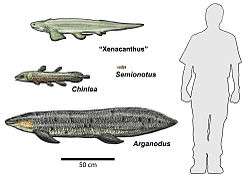Arganodus
Arganodus is an extinct genus of Ceratodontidae (lungfish). Its fossils have been found in the Redonda Formation, New Mexico,[1] the Tacuarembó Formation of Uruguay,[2] and the Cumnock Formation, North Carolina,[3] although the North Carolinian specimens are smaller than most recorded specimens.[3] Fossils have also been uncovered in the Petrified Forest National Park.[4] It was first named by Martin in 1979, and contains two species, A. dorotheae and A. atlantis. Arganodus was probably similar to modern lungfish, and lived in underwater burrows during dry periods until monsoons occurred.[4]
| Arganodus Temporal range: Late Triassic-Late Jurassic | |
|---|---|
 | |
| Arganodus (bottom) and other fish from the Chinle Formation | |
| Scientific classification | |
| Kingdom: | |
| Phylum: | |
| Class: | |
| Order: | |
| Family: | |
| Genus: | Arganodus Martin, 1979 |
| Species | |
| |
References
- "The Microvertebrate Fauna of Shark Tooth Hill, Redonda Formation (Late Triassic, Apachean), Quay County, New Mexico". Andrew B. Heckert, Spencer G. Lucas and Adrian P. Hunt, New Mexico Museum of National History. 2005. Archived from the original on 2 June 2008. Retrieved 2008-07-14.
- Soto, M., and D. Perea. 2010. Late Jurassic lungfishes (Dipnoi) from Uruguay, with comments on the systematics of Gondwanan ceradontiforms. Journal of Vertebrate Paleontology 30. 1049-1058.
- "A New Microvertebrate Fauna from the Upper Triassic (Norian) Cumnock Formation, Durham Subbasin, North Carolina, USA". Andrew B. Heckert, Vincent Schneider, Paul E. Olsen, and Sterling Nesbitt. 2006. Retrieved 2008-07-15.
- "Petrified Forest National Park - Vertebrates of the Late Triassic (U.S. National Park Service)". www.nps.gov. 2007-04-13. Archived from the original on 12 June 2008. Retrieved 2008-07-15.
External links
- Arganodus at the Paleobiology Database
- Arganodus at Zipcodezoo.com
- The Geographic Distribution and Biostratigraphy of Late Triassic-Early Jurassic Freshwater Fish Faunas of the Southwestern United States
- www.texasfinearts.com
- Preliminary Review of the Early Jurassic (Hettangian) Fresh Water Lake Dixie Fish Fauna in the Whitmore Pointmemeber, Moenave Formation in Southwest Utah
- The Moncure Microvertibrate Fauna (Upper Triassic: Norian), Colon Cross-structure/Sanford Sub-basin, North Carolina, USA
This article is issued from Wikipedia. The text is licensed under Creative Commons - Attribution - Sharealike. Additional terms may apply for the media files.